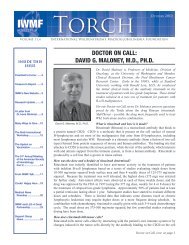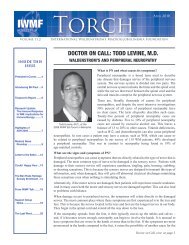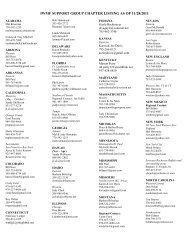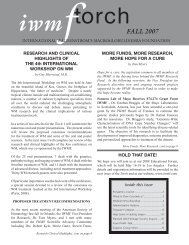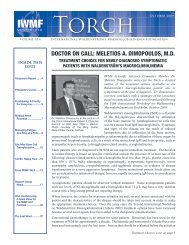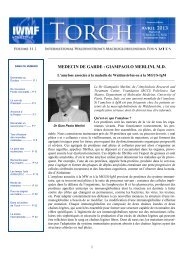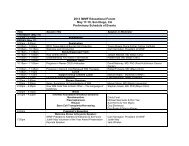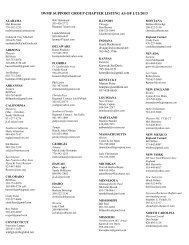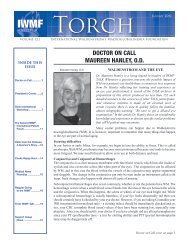SURVIVORSHIP IN CANCER - International Waldenstrom's ...
SURVIVORSHIP IN CANCER - International Waldenstrom's ...
SURVIVORSHIP IN CANCER - International Waldenstrom's ...
Create successful ePaper yourself
Turn your PDF publications into a flip-book with our unique Google optimized e-Paper software.
RESEARCH UPDATE<br />
RESEARCH FUNDED by the IWMF<br />
by Tom Myers, IWMF Vice President for Research<br />
Exciting results have been achieved by IWMF-supported<br />
researchers in the last two years. In 2008 scientists from around<br />
the world met to develop a program that would have promise in<br />
understanding the disease Waldenstrom’s macroglobulinemia<br />
(WM). Their recommendations were to develop cell lines<br />
representative of the disease, breed mice that would acquire<br />
WM, and provide a tissue bank of WM cells available for all<br />
scientists. These “tools” would allow researchers to study the<br />
disease and its treatments without using human patients. Four<br />
researchers were funded by IWMF and LLS to develop cell<br />
lines for different types of WM. After one year at least two<br />
cell lines have been successfully produced by Dr. Ansell of<br />
Mayo and Dr. Chanan Kahn of Roswell Park Cancer Institute.<br />
The projects were funded for an additional year with the<br />
expectation that additional cell lines will be developed by<br />
Dr. Ghobrial of Dana-Farber Cancer Institute and Dr. Suning<br />
Chen of Soochow Hospital in China. The new cell lines will<br />
be available for all WM researchers.<br />
The mouse development under the direction of Dr. Siegried<br />
Janz of the University of Iowa has proceeded exceptionally<br />
well. Dr. Janz reports that he has produced mice which<br />
develop tumors like WM at a fast rate. Further work is<br />
required to develop a mouse strain that produces only IgM<br />
from the tumor cells.<br />
The development of the tissue bank by Dr. Ghobrial has<br />
proceeded slowly because of the difficulty in acquiring<br />
samples. Dr. Ghobrial has suggested some new approaches to<br />
the problem that are being reviewed by the IWMF Research<br />
Committee. IWMF members could help this program by<br />
contacting Dr. Ghobrial and offering to participate in the<br />
program.<br />
Dr. Ansell has made good progress in identifying the proteins<br />
that contribute to the growth and death of WM cancer cells.<br />
Finally, Dr. Treon of Dana-Farber has completed the first whole<br />
genome sequencing of the genes from WM patients. This<br />
project has identified a gene which appears to be specific to<br />
WM patients. This is a major breakthrough in research and<br />
could lead to the development of new treatments for the disease.<br />
At the recent IWMF Educational Forum on WM held in<br />
Minneapolis, Dr. Janz, Dr. Ansell, and Dr. Treon presented the<br />
latest and very encouraging results from their research projects.<br />
Summaries of these three presentations are now available in<br />
the Ed Forum Review: 2011, a separate IWMF publication<br />
mailed to you together with this issue of the Torch. In<br />
addition, the three lectures were recorded at the Forum and<br />
are included in the set of DVDs from the 2011 Ed Forum.<br />
To purchase the 3-disc DVD set, please use the form on the<br />
back cover of the enclosed Ed Forum Review: 2011 or visit us<br />
online at www.iwmf.com<br />
RESEARCH FUNDED by the WMFC<br />
For the past 18 months Dr. Brad Nelson of the British<br />
Columbia Cancer Agency has been busy researching “The<br />
Immune Response to WM: Implications for Immunotherapy”<br />
at the Deeley Research Centre in Victoria, BC, Canada.<br />
Dr. Nelson’s research proposal was approved for funding by<br />
the IWMF Research Committee; however the grant, which is<br />
for two years beginning January 2010, is wholly funded by<br />
WMFC, the Waldenstrom’s Macroglobulinemia Foundation<br />
of Canada (the Canadian chapter of the IWMF).<br />
Recently we have heard much in the news about the<br />
manipulation of the immune system in the fight against<br />
lymphomas. IWMF members can be justly proud of their<br />
support of this timely and groundbreaking research. Below,<br />
Dr. Nelson provides a layperson's summary on the current<br />
progress of his research.<br />
Guy Sherwood, M.D., IWMF Trustee<br />
THE IMMUNE RESPONSE TO WM:<br />
IMPLICATIONS FOR IMMUNOTHERAPY<br />
by Brad Nelson, Ph.D.<br />
As we are all aware, the immune system is responsible for<br />
fighting infections, such as influenza and the common cold.<br />
Interestingly, recent studies have also demonstrated that<br />
the immune system can help control cancer progression<br />
and can even eliminate tumors. Certain white blood cells,<br />
called T-cells, are particularly important for this anti-tumor<br />
immune response. Cancer patients with good anti-tumor<br />
T-cell responses generally have a better prognosis than<br />
those without. Dr. Brad Nelson’s goal is to use therapeutic<br />
vaccination to enhance the anti-tumor T-cell response in<br />
patients with Waldenstrom’s macroglobulinemia and other<br />
lymphoid cancers. In order to do this, he needs to identify<br />
vaccine targets that are unique to cancer. One such target is the<br />
tumor idiotype, which has already been targeted in numerous<br />
vaccine trials for various types of lymphoma and myeloma.<br />
Moving forward, vaccines will likely be most effective when<br />
multiple aspects of the tumor are targeted simultaneously.<br />
Thus, Dr. Nelson’s team is currently working to identify new<br />
targets for WM.<br />
Cancer is caused by mistakes in the genetic code that endow<br />
cells with abnormal growth properties. Some cancer cells have<br />
hundreds or even thousands of mutations, but recent advances<br />
in genomic sequencing technologies make it possible to find<br />
all of these mistakes in an individual’s tumor. The challenge<br />
now is to develop new treatments that target these tumor<br />
mutations. Importantly, some of these mutations can be<br />
detected by T-cells. Dr. Nelson’s team is therefore using this<br />
approach to identify new vaccine targets for WM. They will<br />
then determine which mutations are recognized by T-cells and<br />
use this information to design future immunotherapy trials.<br />
6 IWMF TORCH Volume 12.4



